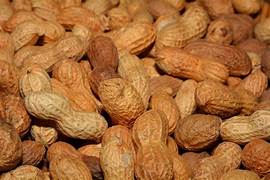Peanuts

Peanut, (Arachis hypogaea), also called groundnut, earthnut, or goober, legume of the pea family (Fabaceae), grown for its edible seeds. Native to tropical South America, the peanut was at an early time introduced to the Old World tropics. The seeds are a nutritionally dense food, rich in protein and fat. if you have ever eaten roasted or fried peanuts you would have noticed they take on a sweet flavor, with hints of chocolate and meat, plus a vegetal undertone. Peanuts are rich in protein, fat, and fiber. While peanuts may have a large amount of fat, most of the fats they contain are known as “good fats.” These kinds of fats actually help lower your cholesterol levels. Peanuts are also an excellent source of: Magnesium. peanuts straight from the ground are nearly translucent and white. Raw, they taste more like peas than nuts but overall, before roasting, salting, grinding or honey glazing, peanuts are fairly bland. peanuts are also a good source of dietary fiber and provide a wide range of essential nutrients, including several B group vitamins, vitamin E, minerals such as iron, zinc, potassium and magnesium, antioxidant minerals (selenium, manganese and copper), plus other antioxidant compounds (such as flavonoids dry hard fruit that does not split open at maturity to release its single seed. A nut resembles an achene but develops from more than one carpel (female reproductive structure), often is larger, and has a tough woody wall. Examples of true nuts are the chestnut, hazelnut, and acorn The peanut is unusual because it flowers above the ground, but fruits below the ground. Typical misconceptions of how peanuts grow place them on trees (like walnuts or pecans) or growing as a part of a root, like potatoes. The bottom line. Peanuts are as popular as they are healthy.